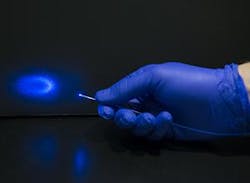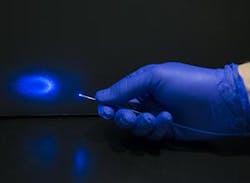Light, rather than painkillers, can activate brain's opioid receptors
Using optogenetics, neuroscientists at Washington University School of Medicine in St. Louis (WUSTL; Missouri) have found a way to activate opioid receptors with LED light rather than opioid drugs (painkillers), which have long been the best option for patients suffering from severe pain. The researchers hope to develop ways to use light to relieve pain, which could lead to better painkilling drugs with fewer side effects.
Related: Light-sensitive switches can treat chronic pain, visual impairment
In a test tube, the scientists melded the light-sensing protein rhodopsin to key parts of opioid receptors to activate receptor pathways using light. They also influenced the behavior of mice by injecting the receptors into the brain, using light instead of drugs to stimulate a reward response.
The researchers are attempting to learn the most effective ways to activate and deactivate the opioid receptor's pathways in brain cells. Michael R. Bruchas, Ph.D., an assistant professor of anesthesiology and of neurobiology at WUSTL and the study's principal investigator, explained that working with light rather than painkilling drugs makes it much easier to understand how the receptors function within the complex array of cells and circuits in the brain and spinal cord.
"It's been difficult to determine exactly how opioid receptors work because they have multiple functions in the body," Bruchas explains. "These receptors interact with painkilling drugs called opiates, but they also are involved in breathing, are found in the gastrointestinal tract, and play a role in the reward response."
So the researchers sought a way to limit opioid receptors to performing a single task at a time, and it turned out to be almost as easy as flipping on a light switch, according to Bruchas, graduate student and first author Edward R. Siuda, and their collaborators, including co-first author Bryan A. Copits, Ph.D., a postdoctoral research scholar in the laboratory of Robert W. Gereau, IV, Ph.D., the Dr. Seymour and Rose T. Brown Professor of Anesthesiology.
By combining the rhodopsin protein, which senses light in the eye's retina, with a specific type of opioid receptor called a Mu opioid receptor, the researchers were able to build a receptor that responds to light in exactly the same way that standard opioid receptors respond to painkilling drugs. When an opioid receptor is exposed to a painkilling drug, it initiates activity in specific chemical pathways in the brain and spinal cord. And when the researchers shone light on the receptors that contained rhodopsin, the same cellular pathways were activated.
In a test tube and in cells, Siuda exposed the receptors to light and then watched as they released the same chemicals that standard opioid receptors release. Then, in mice, the researchers implanted an LED device into a brain region linked to the reward response. They injected the light-sensing receptors they had genetically manufactured into the same brain region. Neurons in that part of the brain release chemicals such as dopamine that create feelings of euphoria.
Working to deliver a similar reward sensation using light, the researchers put the mice into an enclosed chamber. In one part of the chamber, the lighted laser fiber-optic device stimulated the release of dopamine in the brain. When the animals left that part of the chamber, the light in the brain turned off. Soon after, the mice returned to the part of the chamber that activated the fiber-optic device so that the brain could receive more light stimulation.
"By activating the receptors with light, we are presumably causing the brain to release more dopamine," Bruchas explains. "Rather than a drug such as morphine activating an opioid receptor, the light provides the reward."
The researchers were able to vary the animals' response depending on the amount and type of light emitted by the LED. Different colors of light, longer, and shorter exposure to light, and whether the light pulsed or was constant, all produced slightly different effects.
When a person takes an opioid drug such as Vicodin or OxyContin to relieve pain, such drugs interact with receptors in the brain to blunt pain sensations. But over time, patients develop tolerance and sometimes addiction. Opioids also can dramatically slow a person's breathing, too, and typically cause constipation.
In theory, receptors tuned to light may not present the same danger. Siuda said it someday may be possible to activate, or deactivate, nerve cells without affecting any of the other receptors that painkilling drugs trigger, although achieving that goal will be difficult.
Bruchas' team is planning future studies that will use these receptors to test ways to control the brain cells that mediate pain and reward behavior with light rather than drugs.
Full details of the work appear in the journal Neuron; for more information, please visit http://dx.doi.org/10.1016/j.neuron.2015.03.066.
-----
Follow us on Twitter, 'like' us on Facebook, connect with us on Google+, and join our group on LinkedIn

